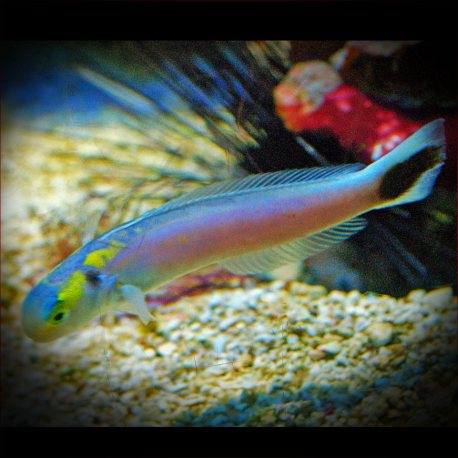More info
Datasheet
| Minimum Tank Size | 400 litres / 105.67 US gallons |
| Maximum Size | 14.0cm / 5.51inches |
| Reef Compatible | Reef safe with caution |
| Temperament | Might be aggressive |
| Temperature | 22.2°C / 71.96°F - 25.6°C / 78.08°F |
| Specific Gravity | 1.020-1.025 |
| Carbonate Hardness | 8-12 |
| pH | 8.1-8.4 |
General Description
The Yellow-spotted tilefish, scientifically known as Hoplolatilus fourmanoiri, belongs to the Malacanthidae family. These delicate species are native to the Western Pacific region. They have a maximum size of 14.0 cm and are characterized by their yellow spots or blotches on their bodies. They are known for their shy and docile temperament.
Aquarium Suitability
The Yellow-spotted tilefish can be challenging to keep and require experience, preparation, and extra care. They are best suited for aquariums with a minimum size of 400 liters, where they can coexist with their own species if introduced simultaneously. These fish prefer a substrate that allows them to burrow, such as sand, coral pieces, shells, and small broken shell fragments.
Demands, Care, and Hardiness
These tilefish require high water quality, including proper oxygenation. They are sensitive to stress and can be easily stressed during transportation and acclimatization. It is crucial to provide them with ample hiding places resembling their natural environment, along with plenty of swimming space. Dim lighting is preferred initially, gradually increasing to normal levels. They need frequent feeding several times a day, especially when newly added, and may benefit from live food to aid in adaptation.
Reef Suitability
Yellow-spotted tilefish are considered reef safe with caution in coral aquariums. They may occasionally go after small shrimp and, rarely, attack LPS corals. However, they generally coexist well with other peaceful fish that spend time in the water column. It is recommended not to keep them with semi-aggressive or aggressive species due to their shy nature.
Aquarium Setup
When setting up an aquarium for Yellow-spotted tilefish, it is advisable to provide dim lighting initially, a substrate that allows burrowing, and secure hiding spots. The tank should have ample swimming space, subdued lighting, and moonlight to prevent the fish from leaping out. Good water quality, proper oxygenation, and a peaceful tank environment are essential for their well-being.
Behaviour
These tilefish exhibit shy and docile behavior, making them vulnerable to stress in the presence of aggressive tank mates. They are known to swim around wildly when stressed and may chase very shy wrasses on occasion. Establishing a peaceful tank environment with suitable tank mates is crucial for their behavioral health.
Feeding and Diet
Yellow-spotted tilefish feed primarily on small crustaceans like Krill, Mysis, and Artemia, as well as zooplankton such as Cyclops and pods. While they may initially require live food, they can transition to frozen food over time. Ensuring they have access to food in the water column, rather than just on the tank bottom, is important for their nutrition.
Habitat and Distribution
Yellow-spotted tilefish are found in the East Indian Ocean, specifically in Indonesia and other parts of the Western Pacific, including Brunei, the Philippines, and the Solomon Islands. They inhabit sandy and coral gravel substrates, preferring to burrow and create holes for shelter. Their natural habitat influences their behavior and care requirements in aquarium settings.

